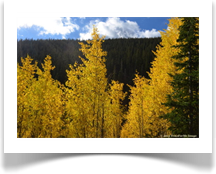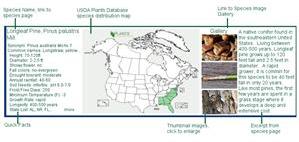

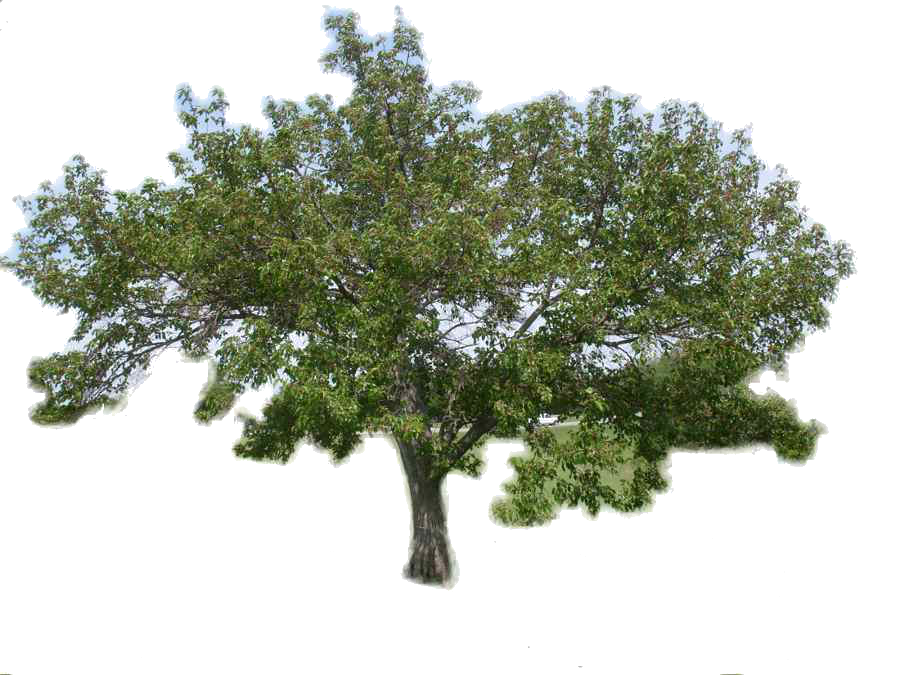
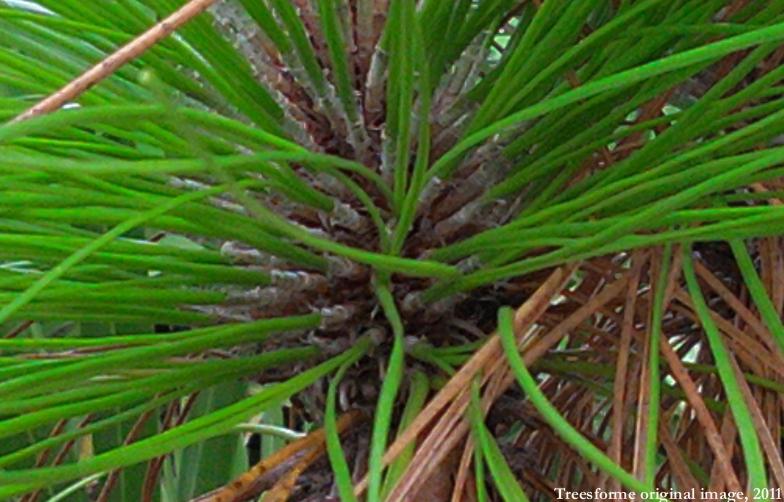

Pinus palustris Mill. is a native conifer found in the southeastern United States. Living
between 400 and 500 years, Longleaf pine grows up to 120 feet tall and 2.5 feet in
diameter. A rapid grower, it is common for this species to be 40 feet tall in only 20
years. Like most pines, the first few years are spent in a grass stage where it develops
a deep and extensive root system. This is a fire adaptation which gives the tree an
ability to sprout from the root collar when top killed. Longleaf pine derives it's name from
the 6 to 18 inch long drooping needles. They are bright green, flexible and grow in tufts
at branch ends. The number of individual needles bundled together varies between 3 in
most of it's range, and 5 in the Gulf area; although sometimes bundles of 2 are found as
well.
Longleaf pine is a leading commericial timber in the southern United States. Uses
include lumber, pulpwood, and veneer. Resin is also collected and used in the
production of turpentine. Turpentine has been used in times past in treatments of a
variety of ailments. Respiratory complaints like coughing, bronchitis, common colds,
and influenza were eased by steam baths and inhalers.
Read more on Longleaf Pines here


October
Quaking Aspen are one of the few high altitude
deciduous trees found in western North
America. Their stunning gold color against the
conifers are one of the many beauties of fall.

Click to enlarge

We are part of the Hubpages community.
Click here for more info.
Click here for more info.

Explore
Learn
By State:
North America:


Forests and Trees of North America
• Read about habitats, botanical information,
insects, Native American and modern uses,
and
more in our species profiles.
• Visit the image galleries to help with
identification
• Visit our F.A.Q. page
• Visit our store front with Amazon.com and
gear up for your outdoor needs. Shop our
selections of apparel, tools, resources and
more, securely and worry free, with a
company you know and trust.
• Like to bring a little of nature into your
home? We've taken some of our favorite
pictures of trees (and the nature surrounding
them) and incorporated them into a wide
variety of items. Cases and covers for your
electronics, board games, puzzles, posters,
wall art, and more, our Zazzle goods are one
of a kind. Shop here!
The forests of North America are arguably the most diverse on the planet. Containing all but two
forest ecology types, species from 81 plant families can be found throughout the multitude of
habitats. Expansive river deltas along the Mississippi River, lowlands throughout the largest
inland freshwater lakes in the world, massive swamps in Louisiana, temperate rainforests in the
Pacific Northwest, arid foothills of the Rocky Mountains, subtropical wetlands in the Florida
Everglades, and boreal forests stretching the length of Canada add to the richness of species
diversity.
Regional Forest Types
Generally speaking, in the eastern United States the most common forest type is oak-hickory. It
is said that when early European colonists headed west, they discovered oak savannahs so
dense one could walk under the massive tree canopies for days barely seeing the sky. A strong
second, the great loblolly-shortleaf pine forests of the southeast stretch from coastal Virginia
south into Florida and follow the Gulf of Mexico over into Texas. Much of the United States
timber economy is centered around pines making the region home to more planted forest land
than anywhere else in North America.
In contrast, the western United States is where you find the giants and rare forest types
preserved for future generations. Dry mountain slopes are home to the chaparrel forest type with
palo verde trees, yuccas and other North American rarities. The predominant forest type,
however, is mixed softwoods consisting of conifers like spruce, redwoods, and fir. Nearly pure
stands of douglas-fir and associated trees are the second most common forest type, followed by
ponderosa pine.
•
• Facts about the forests of North America

• Forest Threats (coming soon)
• About Noxious Weeds
• Federal Noxious Weeds List
• About Invasive Species
• Insects of Concern (coming soon)
• Old Growth Forests (coming soon)
Canada holds the great boreal forest of spruce, fir, larches and aspen, which accounts for 30% of all the boreal forests in the world, and
stretches uninterrupted for over 10,000 miles. Covering about 60% of Canada's land area, it is considered to be the largest intact forest
remaining on Earth. Along the southern border, the cold hardy conifers give way to more deciduous species dotted with stands of jack,
lodgepole, eastern white, and red pines. In addition to the impressive boreal forest, Canada is also home to part of the Pacific rainforest,
holding 25% of the world total of this forest type within its borders. Old growth forests draw tens of thousands every year to British
Columbia where giants festooned with green have stood for centuries.
Forest Facts and Figures
North America holds 17% of the world's forests with well over 900 species in 260 different genera. Leading the United States in forested
land area, Canada has 397 million hectares, or 981.3 million acres, while the United States has 751.2 million acres, or 304.1 million
hectares. In fact, the two countries rank 3rd and 4th respectively in the world for percentage of forested land area behind the Russian
Federation and Brazil.
The most diverse tree populations in the United states are found in Florida, Kentucky, Texas, and California. California, Florida, and
Texas have unique habitats which allow for species to exist locally but no where else in North America. Kentucky, on the other hand,
enjoys diversity as the many northern and southern species ranges overlap, as well as having varying terrain. Kentucky is second to only
Florida in the number of tree species found within the state.
Quick Facts
United States:
• 55% of the timber land is less than 50 years old
• 6% of the timber land is more than 175 years old
• Produces 25% of the world's commercial timber
• ranked 4th in the world for percentage of forested land
• Home of the world's tallest tree- Redwood, 379 feet. Discovered
in 2006, named Hyperion. Located in California
• World's heaviest pine cones, up to 5 pounds- Pinus coulteri
• World's longest pine cones, up to 24 inches- Pinus lambertiana
• Tallest tree species (in no particular order):
Redwoods
Giant Sequoia
Western Red cedar
Sitka Spruce
Douglas Fir
Bald Cypress
Cottonwood
Sugar Pine
Oaks
Eastern White Pine
• Predominant forest types:
Eastern- Oak-Hickory
Western- Mixed softwoods (conifers)
• 116 Federally classified threatened or endangered species
(includes species in Hawaii and Puerto Rico)
• National tree is the oak
• See state pages for state tree information
• Home to the largest remaining cypress forest in the world.
Caddo Lake, Louisiana/Texas border
Canada:
• Contains 10% of the world's forest cover
• Contains 30% of the world's boreal forests
• Home to more than 25% of the world's remaining temperate
rainforests
• ranked 3th in the world for percentage of forested land
• 67% of Canadian forests are composed of conifers
• 16% are broadleaf
• Predominant tree species:
Spruce- 53%
Poplar- 11%
Pine- 9.3%
• Most of the forests (93%) are publicly owned
• 80% of Aboriginal communities are in forested areas
• World's leading exporter of soft lumber, newsprint, and
pulpwood (by value)
• National tree is the maple
• Arboreal emblems for each province and territory are:
Alberta- Lodgepole Pine
British Columbia- Western Redcedar
Manitoba- White Spruce
New Brunswick- Balsam Fir
Newfoundland and Labrador- Black Spruce
Northwest Territories- Tamarack
Nova Scotia- Red Spruce
Nunavut- No designation
Ontario- Eastern White Pine
Prince Edward Island- Red Oak
Quebec- Yellow Birch
Saskatchewan- White Birch
Yukon- Subalpine Fir
Economy
Timber lands play an important role in the economies of both Canada and the United States as a major source of employment and
driver of exports. Canada exports (by volume) more softwood, newsprint, and pulpwood products than anyone else and exports the
most to the United States by far. Overall, the forest industry contributes about 1.9% ($23.7 billion, 2011) to Canada's GDP and
employs around 234,000 people. As well as one of the world's leading consumers, the United States is also one of the world's leading
producers, producing 25% of the world's commercial timber products. The U.S. forest products industry accounts for $200 billion in
sales a year and employs over 1 million people.
The tourism industry is also fueled by the preservation of forests in state and national forests and parks. Much of the United States
timber land is managed and harvested from sustainable planted forests on park lands. Over 165 million people visited the lands
maintained by the forestry service in the United States in 2011 alone, helping to support over 200,000 jobs. The same is true of
Canadian forests, although the numbers are not quite as high. As of 1994, 1 in 15 jobs in Canada was related to forestry in one way
or another. The current number may be lower as the forest industry was hit with huge set backs when the housing market in the
United States crashed and the timber demands diminished significantly. Another of Canada's main exports, newsprint, is also on a
permanent decline as more and more paper formats are going digital.
Tree Families, Genera, and Species Facts
According to the United States Department of Agriculture, NRCS, there are 950 (not including specie varieties or subspecies) tree
species in 81 plant families native to North America. There are also over 100 non-native tree species that have escaped cultivation
and are naturalized in the wild. Search our collection of tree families and genera here.
Below are a few facts about tree families in North America:
• The Pea family, Fabaceae, has 27 genera with tree species- more than any other.
• Families with the most tree species are:
• Rose, Rosaceae- 201 species
• Beech, Fagaceae- 90 species
• Pine, Pinaceae- 66 species
• Pea, Fabaceae- 56 species
• Willow, Salicaceae- 49 species
• Genera with the most tree species are:
• Hawthorn, Crataegus (Rose family)- 153 species
• Oak, Quercus (Beech family)- 84 species
• Willow, Salix (Willow family)- 42 species
• Pine, Pinus (Pine family)- 39 species
Famous Trees
• Methuselah tree- A Great Basin bristlecone pine that is estimated to be 4844-year-old and is the 2nd oldest living tree.
• General Sherman- By volume is the largest known living single stem tree on Earth.
• Pando, also known as The Trembling Giant, is a clonal colony of a single male quaking aspen. By testing the genetic markers for
each stem (roughly around 40,000), it has been found to be a single living organism with one root system. The plant is estimated to
weigh approximately 6,600 short tons, making it also the heaviest known organism. The root system of Pando, estimated 80,000
years old, is among the oldest known living organisms.
• Balmville Tree- Oldest known eastern cottonwood (Populus deltoides) in the eastern United States. Balmville, NY. Once visited by
Benjamin Franklin. Core samples indicated it started growing around 1699.
• Chandelier Tree- Famous coast redwood tree in Leggett, California with a 6' wide by 6' 9" drive through hole in the trunk.
• Comfort Maple- Estimated to be 500 years old, this Sugar Maple (Acer saccharum) is located in Pelham, Ontario and is one of the
oldest trees in Canada.
• Hangman's Elm- At an estimated 310 years old, this is the oldest tree in Manhattan, NY.
• Stratosphere Giant- Discovered in Humbolt State Park, CA in 2000, this Redwood (Sequoia sempervirens) was once ranked as the
tallest tree in the world. It stands at 368.6 ft tall but was beaten out by a newly discovered 379.1 ft redwood named Hyperion in 2006.
• Lost Monarch- The worlds 3rd largest (by diameter) redwood. Measuring 26 feet D.B.H. (Diameter at Breast Height), it is a giant
among giants in northern California's Grove of Titans.
• Moon trees- 500 tree seeds were taken into space on Apollo 14 in 1971. The species were Loblolly Pine, Sycamore, Sweetgum,
Redwood, and Douglas Fir. Of the 500 seeds, 420-450 were sucessfully germinated and the seedling were planted at various state
forestry locations and government buildings in Alabama.
• Pinchot Sycamore- Largest tree in Connecticut.
• Survivor Tree- An 80 ft tall American Elm in the center of downtown Oklahoma City, OK that survived the Oklahoma City bombing on
April 19, 1995. Heavily damaged, burned, and nearly cut down during the bombing investigation, most thought the tree would perish.
It began to bud the following year and has now become part of the memorial. Hundreds of seeds from the Survivor Tree are planted
annually.
Lake
County,
Colorado
Sept.
2013
Photo
courtesy
Elliott
Flint





™

Custom Search

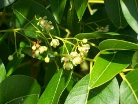
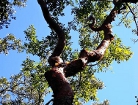

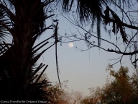
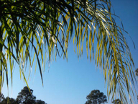

Want to add your tree to our picture gallery? Click here for details!
-Color denotes a tree that is rare or endangered

For state A-Z list click state name below:

Welcome to TreesForMe, a resource for information on North American native trees.

